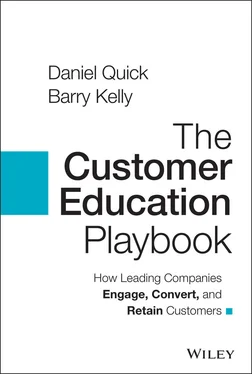If your customer education team is tasked with maximizing customer success, try asking your CSMs to list the things that they say repeatedly to most of their customers: the standard onboarding questions that they answer, the company information they provide, or even the sales pitch repeated for new customers who join the account. If you can create content that covers this material, then you're leaving your CSMs with a lot more time to deal with more nuanced questions around use cases, which is likely to offer far more strategic value to your customers.
One idea to cover this material is to run an ongoing live webinar program teaching the basics of your product, and then strongly promote it to new customers. If your product is relatively complex, you might also run additional webinars to teach more advanced material. You can also record on-demand versions of the webinar. Then, you can provide these prerecorded versions to customers whenever they choose, or you can schedule to play them live at a regular cadence, while ensuring someone is standing by for live questions.
Is It Working? How to Assess Learning Experiences
It's one thing to offer learning; it's another to know whether learning takes place. It's not enough to set up a learning experience; you must also ensure that you know whether your material is making a difference.
One practical way to see when customers are ready for the next level of strategic conversations with CSMs is to create a commonly accepted signal that shows that customers have a certain level of foundational knowledge. On a basic or initial level, this signal could be based on such metrics as percentage of training starts or completes, drop-off points, or the amount of time spent training. For a signal that you can use for a more advanced user, you can also set up a credential or an award that's based on passing a well-designed assessment. Sometimes described as getting certified , passing the test would result in a credential of some kind: a certificate or even a digital badge to post on LinkedIn.
At Optimizely, in an effort to increase customer value, the customer success team implemented a “Get Trained” program that prompted customers to get product certified by a certain date and gently nudged them toward this goal. In an initial kick-off call, the CSM would outline the training program and would mention that they would speak again once the training was complete. It was up to customers to decide how they wanted to learn the product. They could choose between courses, webinars, YouTube videos, and more, as long as they could pass the test. Customers would be prompted to complete the training, and on completion, the CSMs would get a notification to book the next strategy meeting, where they could congratulate the customer on completing the training and see what the customer needed next. While previously CSMs had felt that they were constantly dealing with very basic questions, after this program was put into place, CSMs spent far more time providing strategic value, and they reported that customers were asking much more sophisticated questions.
Made to Measure: Proving the Quantitative Worth of Supporting CSMs
In your efforts to scale customer success, you'll want to focus on improving several metrics. First, ensure that your customers are actually engaging with your education by tracking and improving the percentage of customer accounts who have completed the content. If your product touches multiple users, measure depth as well as breadth. That is, in addition to getting more accounts trained, you'll also want to get more users on each account trained.
Second, create a source of explicit data by asking your CSMs the same question periodically. Something like, “On a scale of 1–10, how strategic have your conversations with customers been?” Then, augment that with qualitative data: Interview your CSMs to get a sense of how the education has helped them in their roles.
Third, check to see whether your education impacted customers further down the funnel. What does lifetime value (LTV) look like for trained customers versus untrained customers? What does churn (turnover) look like? In other words, measure the impact of customer education in the same way you measure the impact of customer success.
Finally, one of the best ways to determine whether you're scaling customer success requires you to track how customer education impacts time to value (TTV) – the amount of time it takes for new customers to realize value from your product. A goal of customer education is to reduce TTV so that your customers are gaining value as quickly as possible, with minimal friction.
If your company is not currently tracking TTV, we highly recommend you start. To do so, you must first define what value means. More specifically, what does value mean to your customers? What is their “ aha! ” moment? And how is that value “captured” as a metric (or cluster of metrics) in your product? In the next chapter, you'll learn more about how to define success for your customers and strategically improve their perceived value.
Goal 4: Create Brand Ambassadors
If your organization's goals are about building advocates, product champions, or brand ambassadors, then your customer education should work to build better brand trust and loyalty. What you want are customers who will spread the word about your product and tell their friends about you. To do so, they need to be totally bought into the value of your product or service, which not only means you need to move people from being novices to masters, but also to seeing your product as indispensable.
To create learning experiences that build advocacy, look to craft a learning journey that encourages three things:
1 Mastery
2 Delight
3 Connection
These ingredients make up the secret sauce of brand advocacy. For example, you might offer the opportunity to complete a course (mastery) that earns you a digital badge (delight), which you can then post and share on social media or in a customer forum (connection). Throughout this education path, you can also encourage your users to make their everyday work easier using your product, which can help them see you as an indispensable tool.
Once you've developed mastery, delight, and connection, you need to provide avenues for your brand ambassadors to advocate on your behalf. Think about creating community moderators in your forums, for example, or asking for guest experts to join your webinars and post thought leadership content on your website. Provide direct opportunities for your customers to promote you, such as via referrals, regional in-person meet-ups of advocates and prospects, or train-the-trainer programs, where your advocates are channeling that delight to work on your behalf.
Social learning has been shown to exponentially magnify loyalty and enthusiasm in your customers. Look for ways to give existing advocates an everyday opportunity to share their best practices and network with peers, and make sure they have an audience to listen to them rave about you! These everyday avenues can be customer forums, social media channels, or even in-person events. According to Forrester's Benchmark B2B Social Marketing Efforts report, 75 percent of customers who utilized community-generated information have greater satisfaction on using your product, which of course leads to better brand loyalty.
Made to Measure: How to Track Brand Ambassadors
Start with your easy metrics. If you have a certification program, how many customers are getting certified or expressing interest in certification? How many members have you added to your online community, if relevant? These numbers show how well you're doing in reaching and engaging your audience. You'll also want to measure the impact of these programs by comparing the behaviors of two cohorts: those who are engaging with your content and those who are not.
Читать дальше












